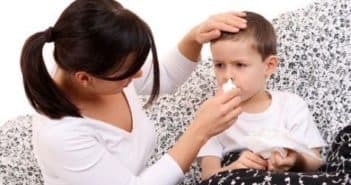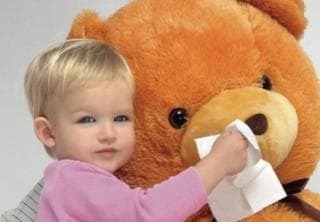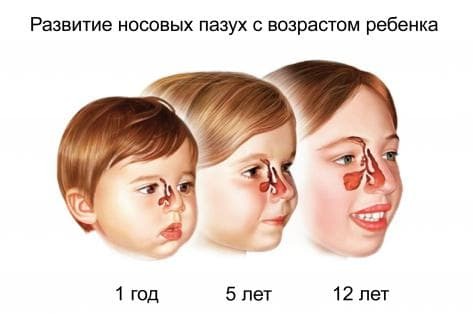
Sinusitis - an inflammatory process that affects the maxillary sinus. Distinguish between one-sided and two-sided. The location of the maxillary sinuses is located near the orbit, oral and nasal cavity. This finding explains the manifestations of sinusitis. The presented ailment very rarely affects children at the age of 2 years, but despite this in medical practice, there are situations when such small patients are brought to the reception.
Content
- 1 Symptoms
- 1.1 Acute sinusitis
- 1.2 Chronic
- 2 Therapeutic measures
- 2.1 nasal lavage
- 2.2 laser treatment and physiotherapy
- 2.3 Antihistamine medications
- 2.4 Other activities
Symptoms
Sinusitis is divided into acute and chronic forms. For each of them is inherent in its course of pathology.
Acute maxillary sinusitis

This form of ailment in children of 2 years is a consequence of acute rhinitis, influenza, scarlet fever and other infectious diseases that have been woven in complex form.
For acute sinusitis, the following symptoms are typical:
- feeling of tension and pain in the area of the inflamed sinus;
- poor nasal breathing;
- discharge from the nose, often purulent;
- fear of light and copious discharge of tears.
How to use Azithromycin for genyantritis, please see this article.
Painful sensations are often blurred and incomprehensible. Focuses pain in forehead, temple. In children, when examined, the doctor can diagnose swelling of the cheeks and swelling of the eyelid. When probing the anterior wall of the maxillary sinus, the child feels pain.
The baby's body temperature can rise and chills occur. During the examination of the middle nasal passage, a purulent discharge can be detected. With a rhinoscope at the back of the pharynx of the nasopharynx, there are discharges of a purulent nature. On the x-ray, inflamed sinuses are noticeable. For an accurate diagnosis, the doctor can prescribe a trial sinus puncture.
From this article, you can learn how to treat maxillary sinusitis without a puncture.

Chronic form of
This inflammation is the result of acute inflammation. Its development occurs with repeated acute and protracted sinusitis. The main causes of the transition of the acute form into the chronic are in the adenoids, the curvature of the septum of the nose.
The disease is as follows:
- bad breath from the mouth;
- pain syndrome in the area of the inflamed sinus;
- painful sensations when probing the anterior wall of the sinus;
- headache, inactivity of the child;
- swelling of the cheeks and swelling of the eyelids;
- cracked skin at the entrance to the nose.
What antibiotics for sinusitis and sinusitis should be taken and what not, you can find out by reading the article.
For chronic sinusitis is characterized by hypertrophy of the mucosa and the formation of polyps. At the moment of remission, the baby feels satisfactory, the discharge from the nose is insignificant.
Exacerbation of sinusitis occurs very often. In this case, he is visited by such symptoms:
- elevated temperature;
- copious discharge from the nose;
- general condition disorder;
- conjunctivitis.
If in time to not start adequate therapy, then against a background of reduced immunity will occur phlegmon orbit, meningitis or sepsis.
Therapeutic events
Once you have discovered the first symptoms of this dangerous ailment, you must urgently go to the reception in the clinic. Only timely therapy guarantees a successful outcome. In home treatment after receiving permission from a doctor, you can conduct warming up, washing. Very often they have a positive impact and can eliminate serious consequences. If you cure maxillary sinusitis in a child of 2 years did not work at an early stage, then it is worth taking more serious measures. A medical course for a child is prescribed by an otolaryngologist. Only this doctor will be able to assign effective therapy to a small patient with the help of medication. Treatment of ailment in children can be carried out both at home and in the hospital. Everything depends on the severity of its current.
How correctly to take drops in the nose with antibiotics from sinusitis, you can find out by reading this article.

Nasal flushing
Very often, the treatment of sinusitis in a 2-year-old child involves the use of procedures such as rinsing, phototherapy and exposure to the laser. The most effective and popular method is the washing of the nose. There are 2 ways to perform this manipulation: "cuckoo" and catheter management.
How to take Sinupret with genyantritis is indicated in this article.
The first method is characterized by the introduction of 2 catheters into the nasal passages, one enters the drug composition, and the other purges the purulent contents. The "cuckoo" method has such a name, since the baby is forced to repeat the cookie so that the liquid is not swallowed during the procedure.
The second method is characterized by removal of purulent contents by the principle of alternating positive and negative pressure in the nasal sinuses. After a few such procedures, a significant improvement in the child's condition is noted.
How to properly apply Amoxicillin for sinusitis, indicated in the article.
The video tells how to rinse the nose to young children:
It is dangerous if the genyantritis can be found after reading this article.
Laser treatment and physiotherapy
The presented kind of therapy is considered very popular because of its painlessness. More doctors can prescribe physiotherapy. It has a beneficial effect on the elimination of the inflammatory process. As for acupuncture, this manipulation is not practically prescribed for children 2 years old.
How to treat bilateral sinusitis is indicated in the article.
Antihistamines
Such treatment is advisable to carry out in the case when it is necessary to introduce accumulated fluid in the nasal sinuses. As a rule, the duration of acute sinusitis in children is 1-2 weeks. Chronic can disturb for about a month. There are situations when you can not do without a puncture.
The video describes in detail about sinusitis in children:
Other events
Specialists do not advise to perform independent therapeutic actions for sinusitis in young children. Such negligence can lead to serious consequences. There are only more specific methods that are allowed for exercise at home: massage procedures and respiratory gymnastics.
How to use Sumamed in genyantritis is indicated in this article.
When the child was struck with the first signs of ailment, you can tap a phalanx of the thumbs on the nose bridge slightly. The duration of such events is 2 - 3 minutes 2 times per hour. You can massage at specific points in the clockwise direction. You can massage the internal corners of the eyebrows, along the middle line between the eyebrows,
Breathing exercises involves alternating breathing through one and the second nostril. For 5 minutes, it is necessary to ask the baby to perform such activities and after the first session he will feel considerable relief.
This article indicates infectious sinusitis or not.
Treatment of sinusitis in a child is an important activity. If they are not carried out in time, then such consequences as otitis media, pneumonia, oedemas can occur. To avoid this, you need to learn to distinguish the symptoms of this insidious disease and immediately eliminate them after agreeing all the actions with your doctor.
